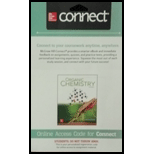
Connect Access Card Two Year for Organic Chemistry
5th Edition
ISBN: 9781259636424
Author: Janice Gorzynski Smith Dr.
Publisher: McGraw-Hill Education
expand_more
expand_more
format_list_bulleted
Question
Chapter 16, Problem 16.26P
Interpretation Introduction
Interpretation: The product (A) for the given Diels-Alder reaction is to be drawn.
Concept introduction: Diels-alder reaction is a cycloaddition reaction in which two molecules combine to form a new ring. In this type of reaction, syn addition takes place. It is a reaction between diene with a dienophile to yield a cyclohexene. The dienophile adds to one side of the diene, and diene adds to the one side of the dienophile. Thus, they have syn stereochemistry
Expert Solution & Answer
Want to see the full answer?
Check out a sample textbook solution
Students have asked these similar questions
(A) Which triene has the smallest heat of hydrogenation? Explain why.
(B) Which triene can be reactive in the Diels-Alder reaction?
(C) Which triene is the most reactive in the Diels-Alder reaction?
The molecule in the box is the product of a diels alder reaction. Which of these is the dienophile in that reaction ? A B C D or E?
Draw a product of the following reaction. Indicate the stereochemistry of the Diels-Alder product.
Chapter 16 Solutions
Connect Access Card Two Year for Organic Chemistry
Ch. 16 - Prob. 16.1PCh. 16 - Prob. 16.2PCh. 16 - Problem 16.3 Draw a second resonance structure for...Ch. 16 - Prob. 16.4PCh. 16 - Problem 16.5 Farnesyl diphosphate is synthesized...Ch. 16 - Prob. 16.6PCh. 16 - Prob. 16.7PCh. 16 - Prob. 16.8PCh. 16 - Problem 16.9 Determine the hybridization of the...Ch. 16 - Problem 16.10 Draw the structure consistent with...
Ch. 16 - Problem 16.11 Neuroprotectin D1 (NPD1) is...Ch. 16 - Problem 16.12 Using hybridization, predict how the...Ch. 16 - Problem 16.13 Use resonance theory to explain why...Ch. 16 - Prob. 16.14PCh. 16 - Prob. 16.15PCh. 16 - Problem 16.16 Draw the products formed when each...Ch. 16 - Problem 16.17 Draw a stepwise mechanism for the...Ch. 16 - Prob. 16.18PCh. 16 - Problem 16.19 Draw the product formed when each...Ch. 16 - Prob. 16.20PCh. 16 - Prob. 16.21PCh. 16 - Problem 16.22 Rank the following dienophiles in...Ch. 16 - Prob. 16.23PCh. 16 - Prob. 16.24PCh. 16 - Problem 16.25 What diene and dienophile are needed...Ch. 16 - Prob. 16.26PCh. 16 - Problem 16.27 Which compound in each pair absorbs...Ch. 16 - Prob. 16.28PCh. 16 - 16.29 Name each diene and state whether the...Ch. 16 - Prob. 16.30PCh. 16 - 16.31 Which of the following systems are...Ch. 16 - 16.32 Draw all reasonable resonance structures for...Ch. 16 - Prob. 16.33PCh. 16 - Prob. 16.34PCh. 16 - 16.35 Explain why the cyclopentadienide anion A...Ch. 16 - Prob. 16.36PCh. 16 - 16.37 Draw the structure of each compound.
a. in...Ch. 16 - Prob. 16.38PCh. 16 - 16.39 Label each pair of compounds as...Ch. 16 - Prob. 16.40PCh. 16 - 16.41 Draw the products formed when each compound...Ch. 16 - Prob. 16.42PCh. 16 - 16.43 Treatment of alkenes A and B with gives the...Ch. 16 - 16.44 Draw a stepwise mechanism for the following...Ch. 16 - Prob. 16.45PCh. 16 - 16.46 Explain, with reference to the mechanism,...Ch. 16 - Prob. 16.47PCh. 16 - Prob. 16.48PCh. 16 - Prob. 16.49PCh. 16 - Prob. 16.50PCh. 16 - Prob. 16.51PCh. 16 - Prob. 16.52PCh. 16 - 16.53 Diels–Alder reaction of a monosubstituted...Ch. 16 - Prob. 16.54PCh. 16 - 16.55 Devise a stepwise synthesis of each compound...Ch. 16 - Prob. 16.56PCh. 16 - 16.57 A transannular Diels–Alder reaction is an...Ch. 16 - Prob. 16.58PCh. 16 - Draw a stepwise mechanism for the following...Ch. 16 - Prob. 16.60PCh. 16 - Prob. 16.61PCh. 16 - Prob. 16.62PCh. 16 - Prob. 16.63PCh. 16 - Prob. 16.64PCh. 16 - 16.65 The treatment of isoprene with one...Ch. 16 - 16.66 The treatment of with forms B (molecular...Ch. 16 - Prob. 16.67PCh. 16 - Prob. 16.68PCh. 16 - Prob. 16.69PCh. 16 - Prob. 16.70PCh. 16 - Prob. 16.71PCh. 16 - Prob. 16.72PCh. 16 - Prob. 16.73PCh. 16 - Prob. 16.74PCh. 16 - Prob. 16.75P
Knowledge Booster
Similar questions
- A Diels-Alder reaction produces the following major product. Draw the structure of the diene onlyarrow_forwardIllsutrate the Energy diagram for carbocation formation in two different SN1 reactions ?arrow_forwardDraw the reactants that would be used to form this cyclohexene derivative in a Diels-Alder reaction. Include any relevant stereochemical configurations.arrow_forward
- Draw the products of the following Diels–Alder reactions. Indicate stereochemistry where appropriate and show the pushing mechanism for a and barrow_forwardWith this in mind, draw the product when each compound undergoes anintramolecular Diels–Alder reactionarrow_forwardDraw the products of the following Diels-Alder reactions, and indicate the stereochemistry at all stereogenic centers.arrow_forward
- Draw the products of the attached Diels–Alder reactions. Indicatestereochemistry where appropriate.arrow_forwardWhat cyclic product is formed when each decatetraene undergoes photochemical electrocyclic ring closure?arrow_forwardRank the following dienes from most to least reactive in a Diels-Alder reaction. Provide an explanation for each ranking. Draw a mechanism and show the product for the following reaction, paying close attention to stereochemistry.arrow_forward
arrow_back_ios
SEE MORE QUESTIONS
arrow_forward_ios
Recommended textbooks for you
 Organic Chemistry: A Guided InquiryChemistryISBN:9780618974122Author:Andrei StraumanisPublisher:Cengage Learning
Organic Chemistry: A Guided InquiryChemistryISBN:9780618974122Author:Andrei StraumanisPublisher:Cengage Learning

Organic Chemistry: A Guided Inquiry
Chemistry
ISBN:9780618974122
Author:Andrei Straumanis
Publisher:Cengage Learning